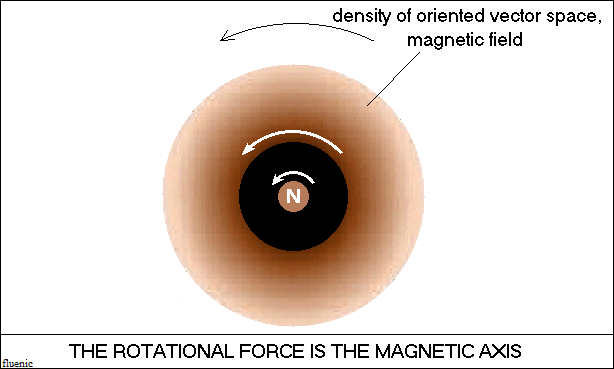The source of nature.
In vector space, the properties of vectors (the force of attraction) form
a
closed vector circuit. Simultaneously, the axial rotation property of
vectors,
with their sense of rotation, forms another orthogonal closed vector circuit
(the enigmatic right-hand rule). For a better understanding, we consider
vector circuits, two single wires, like chain links. Circuits are neither
electric
nor magnetic, but we can call them whatever we want, they remain vector
circuits, without displacement, without electric charges. But, orthogonally
closed vector circuits are not singular circuits, they are vector space,
oriented
in orthogonally closed circuits. These circuits having microscopic dimensions
are symmetrical and identical to each other. The attractive forces in
each
circuit compress each other's density. Thus, the circuits being parallel,
surround each other by more than half the circumference of the other circuit.
The microscopically formed vector structure is called a hydrogen atom,
vector space, self-compressed to the solid state, potential energy.
The shape and size of the vector structure called hydrogen is constant
and
through their connections with closed vector circuits, they form the elements.
This structure denotes that vector space is the source, the origin from
which
nature comes. With or without hydrogen structures, macroscopic
orthogonally closed vector circuits, asymmetric and called stars, are
formed
in vector space. The asymmetry comes from the macroscopic dimension, in
which one of the circuits is completely surrounded by the other circuit,
called
magnetic and electric. The electrical circuit surrounded and compressed
by
the magnetic circuit, compresses only a segment of the magnetic circuit,
called the magnetic axis.
Axial rotation in the universe.
The magnetic axis is a compressed vector space, in which the axial rotation
of vectors in the same sense is the cause, the force that produces the
vortex
of macroscopic vector structures in the universe. Right-hand rule - the
cause.
Since microscopic structures are symmetrical, hydrogen has no magnetic
axis, so it does not rotate. The phenomenon is demonstrated in the Earth's
atmosphere, where a cyclone is initiated by the upward movement of water
vapor, apparently a sequence of the water cycle in nature. Apparently,
because, in a subsidiary way, the movement of the water circuit in nature
orients the polarities of vector space into orthogonally closed circuits,
which
compress each other. Comparing the upward motion with the axis of a
magnetic field, visibly compressed by an electric field, shows us the
effect
and sense of rotation of the magnetic axis, the vortex. The open vector
polarities from the magnetic axis being parallel repel each other, the
density
of the oriented space and the temperature decreases and the water vapor
becomes hail driven by the vortex. In the terrestrial polar zones, the
phenomenon is the same, the temperature drops to minus 80 degrees Celsius
and the rotation also pulls the moon into orbit. Obviously, in the terrestrial
cyclone, it is not the wind but the movement of the vector space that
pulls
the substance and objects, considered as being carried by the wind.
Formation of the solar system.
The sun is a star, in the activity of which cyclones are produced, magnetic
vortices observed from the earth. In the activity of the sun, the vortices
reproduced in the gas of the solar atmosphere, macroscopic vector
structures successively rejected in orbits. The gaseous structures cooled,
becoming the planets of the solar system. The size of the planets shows
the
activity of the sun during their formation. The activity of the sun was
much
greater when the planet Jupiter was formed, compared to the activity of
the
sun during the formation of the terrestrial planets, especially the planets
Venus and Mercury. The activity of stars has periods of maximum activity,
when the decomposition reactions of hydrogen structures predominate in
the
photosphere, followed by periods of calm, when the multiplication reactions
of hydrogen structures predominate, and this is repeated periodically.
An indicator of solar activity is the intensity of the magnetism of the
planets and, implicitly, the rotation speed and the number of satellites.
Electric circuit.
Electric and magnetic circuits are vector space, oriented in orthogonally
closed circuits, as are the vector circuits of the hydrogen structure,
of
planets, stars and galaxies. The magnetic field of the sun is vector space,
oriented, with the density of orientation increasing towards the center.
In the chromosphere, the orientation density of the vector space, which
also
contains the density of the hydrogen gas, orients its vector bond polarities
in the direction and sense of the vector space, generating chromaticity.
In the photosphere, where the orientation density of the vector space
is much
higher, it orients the vector polarities of the hydrogen structures, until
they
decompose, in the form of an electric arc. The wire of an electrical network,
without a consumer (load) is the electrostatically polarized wire by Stephen
Gray. The coupling of a consumer closes the electrical circuit and
simultaneously, the magnetic circuit closes around it, which orients
it and compresses the density of the orientation of the electrical circuit.
Circuits are vector spaces oriented in the direction and meaning of closed,
relatively static circuits. The magnetic circuit is obviously a vector
space
oriented in a closed circuit. The electrical circuit is a vector space
oriented
in a closed circuit, which contains the copper structure of the wire,
just as
the photosphere contains hydrogen gas. The orientation density of the
vector space in the wire is produced by the magnetic field and increases
proportionally to the size of the consumer. Increasing the density
of the space in the wire can generate an electric arc, melting the wire.
In the past, for protection, a fusible wire was introduced into the circuit.


